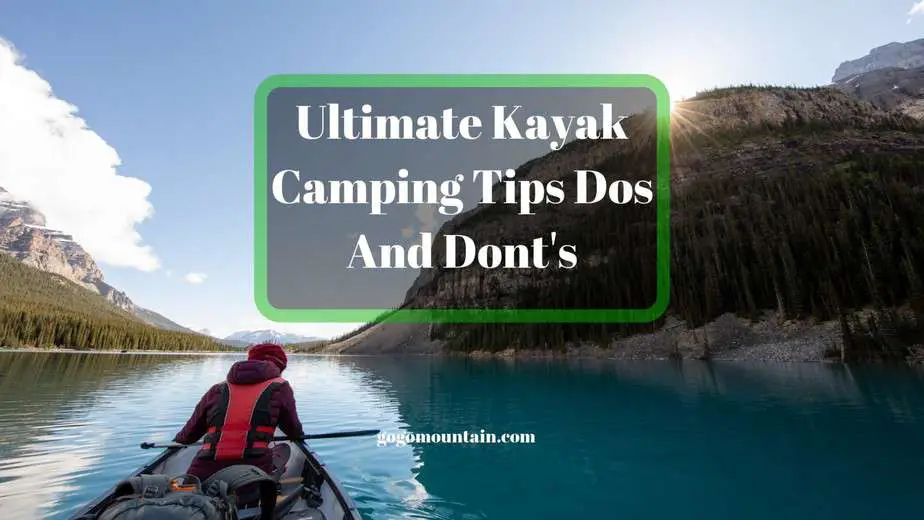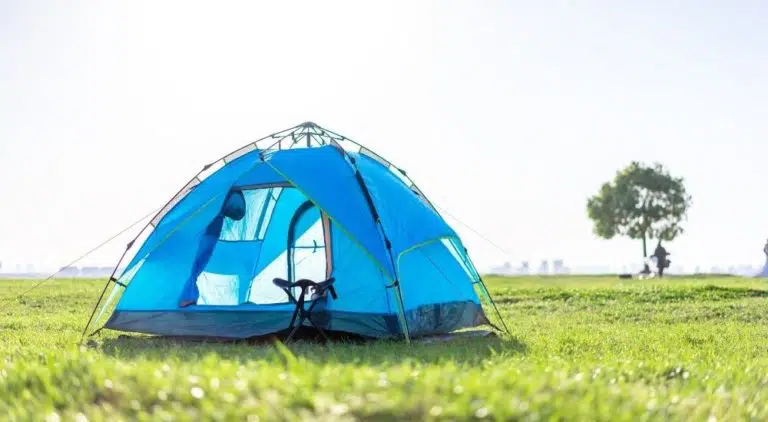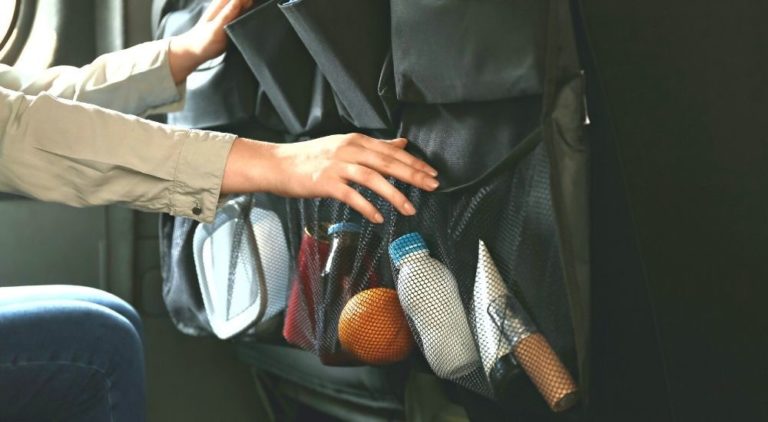Ultimate Kayak Camping Tips – The Dos And Dont’s
Take the weight off your shoulders with kayak camping (both literally and figuratively!) and learn this Ultimate Kayak Camping Tips Dos And Dont’s. The ins and outs of how you can use your kayak for a camping excursion that you will remember for the rest of your life.
Do you enjoy camping? Perhaps you’ve been on your fair share of backpacking trips and are looking to try something new Kayak Camping. Maybe you’re a novice camper altogether!
Whichever statement applies to you, you should know that kayak camping may offer a new alternative to traditional camping.
Essential Tips for Camping With Your Kayak
The main thing you have to remember about kayak camping is that it is not backpacking. Sure, you already know that, but there are some peculiarities and intricacies to which you will need to pay close attention. For example, the hatches on a kayak have a unique shape, and might be something you have not yet considered.
This will mean that you need to plan out your packing list a bit more carefully. While you can stuff your backpack with gear the morning of your trip, you will want to take some time before you head out on your kayaking trip to make sure everything you need to bring will fit inside your kayak.
You should also consider the weight of the items you are bringing. Heavy items must go at the bottom of the boat, and farther away from the stern and bow. This will help keep the weight balanced and prevent unpleasant paddling experiences or worse, the risk of tipping.
Try to avoid putting items on your deck whenever possible. Unless you need a specific item for paddling, don’t leave them on the top of your kayak. Not only will your kayak look like a jumbled mess as you move through the water, but it will also add unnecessary wind resistance and throw off the balance of the entire boat.
You should also avoid putting gear inside the cockpit, because anything that is sitting with you inside the boat will end up in the water if you need to make a wet exit. The only things that should go with you in the cockpit are the things that you absolutely must have during the trip.
Long story short, it if doesn’t fit in the hold, leave it (or something else) behind.
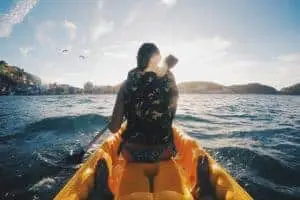
Remember That Waterproof Doesn’t Always Mean Waterproof
Murphy’s Law likes to rear its ugly head when it comes to the hatches of your kayak. Even if you have never experienced water in the hatches of your kayak, know that water always has a way of creeping in when you least expect it. Therefore, any items that must be kept dry under all circumstances should be kept in dry bags or granted all methods necessary to keep them secure. You may need to incorporate added methods of protection to keep your valuables out of the water. These valuables might include anything from your fire-starting equipment to electronics.
Related Post: Top 5 Camping and Fishing Kayaks
And remember, this rule applies tenfold if you are using a borrower or rented kayak. Always assume that the hatches are not watertight.
While dry sacks are a great way to keep your belongings dry, they can be costly. Plus, most kayaks can only fit a few dry bags, so you may be limited by the amount of space you have for bags. It can help to have a few dry bags of all sizes – have some that are medium-sized and some that are small. Whenever possible, pack your belongings down into small bags, because they will be easier to fit into awkward compartments.
There are some other hacks you can consider when packing your kayak, too. By lining the interior of the sack with a trash bag, a sleeping bag that is already encased in a stuff sack can be made into a waterproof bag. The stuff sack will help the trash bag stay in place and allow it to stay waterproof under most conditions. When in doubt, it may be worth it to double bag your sleeping bag, too.
Any items that only need to be kept partially dry can be stuffed into trash bags. This list might include gear like your tent or other outdoor camping equipment. Truly think about the things that need to be kept dry. Your tent poles and stakes, for instance, don’t need to stay dry. You can place them separately in the boat to save space.
Items that don’t need to remain dry can often be placed loosely inside your kayak. It can be tough to find room for a food bag that is packed to the brim with cans, perishables, and other products. However, if you pull out the dry food, like canned goods, that don’t need to stay out of the water you can now find more wiggle room for the smaller bag.
You may find that you have tons of loose items and small bags on long trips. While small bags are easier to pack into a cramped boat, keep in mind that it can be a bit of a hassle to load an unload your boat if it is filled with small bags. Therefore, you might want to have a tarp on hand. You can lay your items on the tarp before you load your boat, as well as when you take items out. This will help you keep track of all of your loose items as you are packing and unpacking.
The Can Will Beat the Bottle
…and the box will beat the can! When you are packing food for your kayaking trip, remember that there are some general rules to adhere to that will make your trip a little easier. And no, you don’t have to eat MREs or dehydrated foods just to save space!
Cans will usually be better than bottles when you are on a kayak camping trip, and boxes will be better than cans. Why? You can burn boxes in your campfire, and you can do so safely. Even if you can’t burn your cardboard, you can always crush them down. The same rule applies for cans – while these can’t be burned, they can be crushed down to save some space. You may have a harder time with plastic bottles, and glass bottles will definitely be off limits.
If you plan on having a tipple or two while you are enjoying your camping trip, consider bringing boxed wine instead of cans or bottles of beer (or worse, bottles of wine). Glass bottles are almost impossible to pack down and very difficult to transport out of your campsite with you. Instead, when you are done with your box of wine, you can throw the box in the campfire and pack the plastic bladder away to be disposed of later.
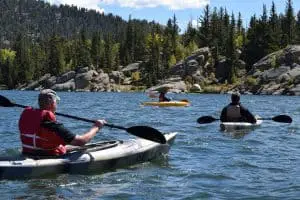
Don’t Compromise Your Diet While Kayak Camping
Many people only pack simple foods like pasta or rice for camping. But you can easily go beyond that and even include fresh meat and vegetables in your diet.
Consider packing frozen meats that will take a day or two to defrost. Think foods like chicken, corned beef, ham, and tuna. You can make a whole host of tasty dishes, including tacos, soups, stews, and more.
You can even pack vegetables! Root vegetables will work well, as they don’t need to be refrigerated and hold up well to the rigors of travel. Consider veggies like carrots, potatoes, yams, beets, or onions. You can also use canned vegetables.
If you choose to bring canned foods on your kayak camping trip, you might want to write the name of the contents on top of the can with a permanent marker. If the cans become wet, they may lose your label, making dinnertime a complete and utter guessing game.
Dried foods are another great source of nutrients. While most people stick to dried fruit as a component of a trail mix (who doesn’t love GORP?) you can also use dried vegetables. Sun dried tomatoes or even zucchini chips can often be used in place of the real thing in recipes. Worst case scenario, they also make fantastic and nutritious snacks. Remember that meats can be dehydrated too – dried beef jerky is a great source of protein when you’re out on the trails or paddling on the water.
If you paddle in cold water, remember to keep any perishable foods at the bottom of your kayak. This will help keep them fresh for a longer period f time, reducing the amount of work (and equipment) you need to carry with you.
Another dinnertime option that is exclusive to kayak camping is the ability to catch some fish. You can catch your own dinner or even harvest some shellfish for a tasty camping treat.
Remember to Stay Hydrated
You will need roughly one gallon of water for every person who is on your camping trip. If you plan on kayaking on a body of freshwater, or even on salt water where you will have access to a reliable source of freshwater, like a stream, you can get away with just carrying a water filter.
Unfortunately, sometimes you will not have access to freshwater on your kayak camping trips. You will need to carry water with you so that you can stay hydrated. And have enough water in case of an emergency that leaves you stranded. Consider carrying a collapsible water container, which will be easier to stash in your boat. Water containers that have hard sides are next to impossible to fit inside a boat.
Even better than collapsible water containers? Those that are flexible. You can find multiple options made by manufacturers like Platypus Water Tank and MSR Dromedary Bags.
And don’t forget about the benefits of boxed wine! While you’ll likely want to bring some libations on your trip, you will want to steer clear of hard bottles and things that cannot be burned to collapsed down into a smaller form. Boxed wine offers the perfect solution. You can reuse the bladders in boxed wine as water bags. All you have to do is drink the wine, then rinse out the bladder. Voila! A 3 liter water bag.
If boxed wine isn’t exactly your style, you can also purchase other drinks in aseptic packaging. You can find milk, juice, and other tipples that will stay good for quite some time until they are opened. Once you open them, they usually have a normal shelf life.
Many people forget that salt water can be used for many of the same applications as fresh water. For example, you can clean yourself and your dishes with salt water – it will have the same cleansing properties, as long as you can abide the feeling of salt water on your skin! You may need to change up the soap that you use, however, as it can be hard to get a good suds or scrub going in salt water at times.
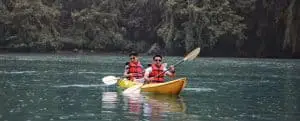
Why Kayak Camping is Super Awesome
You may have heard that kayak camping is a hassle, or that traditional backpack camping is far superior to this waterborne pursuit.
Think again.
Kayak camping blends land and sea in a way that makes a camping trip truly memorable. Sure, there are some other challenges to consider in packing and preparing for your trip. But these challenges are easy to overcome with our adaptable tips.
Here’s a few last tips to get you excited for your next (or first!) kayak camping trip.
Sometimes, getting to the far end of the bow and stern of your boat can be tricky. A good trick is to attach a line to the bag that is sitting the farthest out from you. When you want items on either end of your kayak. All you need to do is tug on the line and the bag will force out any other items along with it. Genius!
One last tip? If you plan on kayak camping frequently, you might want to consider expediting your packing by developing an organization system. For example, you can designate certain colored bags to different types of content – such as toiletries or tent equipment. This will make your materials easy to access and easy to separate – and there’s less risk of leaving something behind, too.
So what are you waiting for? Get packing, get paddling, and get out there.
Posts you might also like:
Top 5 Kayaks for Camping and Fishing
The 18 Best Camp Sites in Florida!
Camping in Northern California – Everything You Need to Know
The Best Generators for Camping

